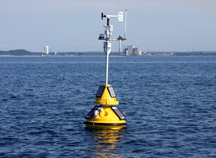New buoy offers real-time Lake Michigan data in Indiana
September 17, 2012
 |
|
A new buoy four miles off the coast of Michigan City,
Ind., in Lake Michigan will provide real-time information on lake conditions
for boaters and others just off the shore. (Illinois-Indiana Sea Grant photo/Anjanette
Riley.) |
WEST LAFAYETTE, Ind. - Boaters and beach-goers visiting the Indiana shoreline of Lake Michigan now can learn current conditions such as water temperature, wind speeds and other information provided by a new environmental sensing buoy.
Placed four miles off the coast of Michigan City on Sept. 4, the buoy is the first of its kind in the Indiana waters of Lake Michigan.
The buoy, jointly owned and operated by Illinois-Indiana Sea Grant and the Purdue University Department of Civil Engineering, will advance the understanding of near-shore waters, alert the public to hazardous conditions, protect water quality and improve weather forecasts. From about April 1 to Nov. 1 each year, the TIDAS 900 buoy will relay real-time information on wind speed, air and water temperature, wave height and direction, and other environmental characteristics.
"This is an understudied area of Lake Michigan," said Cary Troy, a Purdue engineer and principal investigator for the project. "It is an important improvement to now have coverage on this part of the lake where before we did not."
The buoy is important because conditions in the lake's center are much different from conditions closer to shore, said John Taylor, a National Weather Service meteorologist with the northern Indiana office.
"There are not many observations out on the lake itself, and for a long time we only had a single buoy that was 50 miles north of Michigan City," Taylor said. "The more information we have for near-shore areas the better."
Snapshots of lake conditions updated in 10-minute increments are available to swimmers, boaters and anglers on the Sea Grant website at http://www.iiseagrant.org/buoy. The site highlights conditions of particular interest to the lake's recreational users, such as wave height, wind speed and surface water temperature. A webcam provided by the National Oceanic and Atmospheric Administration's Great Lakes Environmental Research Laboratory will allow site visitors to see the area surrounding the buoy in real-time. Graphs showing trends over 24 hours help the buoy be a day-to-day tool for communities that rely on Lake Michigan for food, drinking water and recreation.
"This site allows people to easily access information and better understand the impact real-time data collection has on near-shore research and recreation," said Carolyn Foley, assistant research coordinator for Illinois-Indiana Sea Grant, based out of the Purdue University Department of Forestry and Natural Resources. "Over the years, we plan to include additional tools and applications that could be used to teach people about near-shore ecology. We're working with stakeholders to ensure that what we develop is useful in terms of what data we collect and display and how we choose to display it."
Information collected from the buoy also will be fed into the National Data Buoy Center operated by NOAA. The Michigan City buoy contributes to a worldwide network of buoys and coastal stations, all designed to observe and track marine environmental characteristics.
Data from the buoy will be used by forecasters at National Weather Service offices in northern Indiana and Chicago, the Indiana Department of Natural Resources, and researchers at Purdue to improve predictions of hazardous weather, help the fishing community better target particular species throughout the season and learn more about circulation patterns that affect Lake Michigan's biological activity. With real-time monitoring, researchers will be able to adapt weather, water quality and ecosystem models to the constantly changing lake conditions.
The Illinois-Indiana Sea Grant College Program is one of 30 National Sea Grant College Programs. Created by Congress in 1966, Sea Grant combines university, government, business and industry expertise to address coastal and Great Lakes' needs. Funding is provided by NOAA, U.S. Department of Commerce, the University of Illinois and Purdue University.
Writer: Anjanette Riley (Illinois-Indiana Sea Grant), 217-300-0407, aeriley@illinois.edu
Sources: Cary Troy, 765-494-3844, troy@purdue.edu
John Taylor, 574- 834-1104, john.taylor@noaa.gov
Carolyn Foley, 765-494-3601, cfoley@purdue.edu
Ag Communications: (765) 494-2722;
Keith Robinson, robins89@purdue.edu
Agriculture News Page

